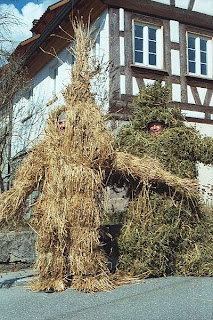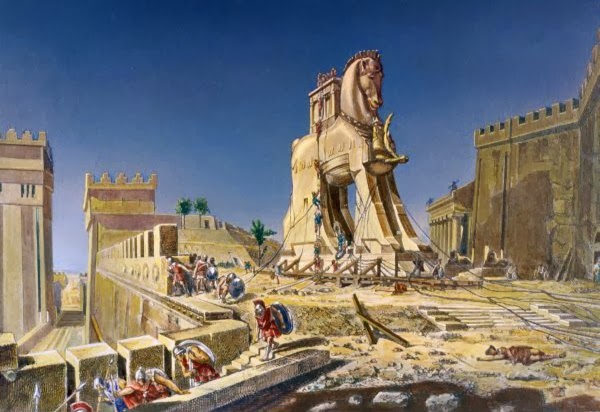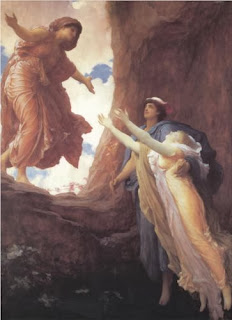1. What is today? (Groundhog Day, Bear Day, Candlemas)
If you're an American, you know that today is Groundhog Day, and that if the groundhog, upon coming out of his hole, sees his shadow (that is, if it's a sunny day), there'll be six more weeks of winter. (Why six weeks? Because that's how long until the spring equinox.)This tradition was brought over by German immigrants in the 19th century. In Germany, it's badgers who are supposed to come out of hibernation on February 2 and predict the weather. But there weren't any badgers in Pennsylvania, where they settled, so they started depending on groundhogs.

It seems likely that bears were the original animal associated with this custom. (At least, that's often asserted to be the case, and it would make sense given that they're the animal we most associate with hibernation.) Bears used to be much more common in Europe than they are now; perhaps when they got scarce people had to turn to other animals for their prognostication needs, much as they turned to the native wildlife when coming to America. We will see examples of several bear-related events that occur on February 2, later in this post.
It is also claimed (for instance, in this book and this book) that this custom is a remnant of ancient bear worship. I will talk more about this in upcoming posts.

It's called Candlemas because there are candlelight processions, and a blessing of the candles that will be used in the upcoming year.
Candlemas is also associated with predicting the weather, even without animals getting involved:
If Candlemas day be dry and fair
The half o' winters to come and mair
If Candlemas day be wet and foul
The half o' winter's gane at Yule. 3
2. What happens on Candlemas?
Here are some other things that go on:In Armenia, there is a fire festival. (The text here is taken from The Golden Bough.)
The materials of the bonfire are piled in an open space near a church, and they are generally ignited by young couples who have been married within the year. However, it is the bishop or his vicar who lights the candles with which fire is set to the pile. All young married pairs are expected to range themselves about the fire and to dance round it. Young men leap over the flames, but girls and women content themselves with going round them, while they pray to be preserved from the itch and other skin-diseases. When the ceremony is over, the people eagerly pick up charred sticks or ashes of the fire and preserve them or scatter them on the four corners of the roof, in the cattle-stall, in the garden, and on the pastures; for these holy sticks and ashes protect men and cattle against disease, and fruit-trees against worms and caterpillars. Omens, too, are drawn from the direction in which the wind blows the flames and the smoke: if it carries them eastward, there is hope of a good harvest; but if it inclines them westward, the people fear that the crops will fail. 3There is a carnival in Oruru, Bolivia, which features folk dancers, a pilgrimage to visit a sacred Condor, Snake, Toad, and Ants, and a play in which the Archangel Michael defeats the Devil and the Seven Deadly Sins. 5
On Crete, there is a cave called Arkoudospilios (Bear Cave). Every year on Candlemas, a festival is held there for Mary as Panagia Arkoudiotissa ("Our Lady of the Bear"). 1 The locals spend the night in the cave and light fires. This story explains what's being commemorated:
According to legend, the bear was drinking the water. Monks from the nearby monastery had wondered why cistern was always empty, and decided to keep watch inside the cave. Suddenly a big bear darkened the entrance, and one of the monks invoked the Virgin Mary, who petrified the bear. 6In the past, this cave was linked to Artemis, who has many associations with bears. I wonder whether she used to have a festival there at this time of year.
![By Wolfgang Sauber (Own work) [GFDL (http://www.gnu.org/copyleft/fdl.html) or CC-BY-SA-3.0-2.5-2.0-1.0 (http://creativecommons.org/licenses/by-sa/3.0)], via Wikimedia Commons Arkoudiotissa cave](https://blogger.googleusercontent.com/img/b/R29vZ2xl/AVvXsEinuzEMFaV-YKGLXypmtbrokBJYAmmnkRvha2iqwTN-FLnM02fWCVEGEsfYu7k_NQlPvwVVOuAgaXY1ocyLiepnfkC_bgaWu3gd6EBNo_jJ7xKdHzhEnSDEQWnYMifReCdAxImcLiisSAQ/s1600/320px-Arkoudiotissa_-_Steinerner_B%C3%A4r_1.jpg)
The large stalagmite is the bear that was
turned to stone by the Virgin Mary.

Jesus's presentation at the temple.
3. What about yesterday? (Imbolc, Saint Brigid's Day, Chinese New Year)
![By malcolm (originally posted to Flickr as Imbolc battle 0001) [CC-BY-SA-2.0 (http://creativecommons.org/licenses/by-sa/2.0)], via Wikimedia Commons Battle between Jack Frost and Green Man](https://blogger.googleusercontent.com/img/b/R29vZ2xl/AVvXsEijNZY4xe6oRcF4uz7Pb9m8s6RxrGu2EOEp6VcPwkFsKExC5ZpwCyS3CDWGxqiXNwA23ioO1uqgj8apW6tmXcaY0fGe073OXxYf46I9uIxC3HGrTGHFjpKuxNVV47v2BLmCzJIZj-W4tVw/s320/640px-Imbolc_battle_Frost_Green.jpg)
Here, Jack Frost is battling the Green Man
![By Culnacreann (Own work) [GFDL (http://www.gnu.org/copyleft/fdl.html) or CC-BY-3.0 (http://creativecommons.org/licenses/by/3.0)], via Wikimedia Commons Saint Brigid's Cross](https://blogger.googleusercontent.com/img/b/R29vZ2xl/AVvXsEgK2WpTQhL8rmxbHs47Eq7OuaR_wmkYtmUGxNbU-NlxW6YJZIEs-zTR_C57w9FHt-OAXnFmoD8X0Bxt7wXpHwetEmjVcccTEPe7QC3SI452xfr1Q2ExEWcwK1H_gukLTpGG9eRltJdfUE0/s320/247px-Saint_Brigid%2527s_cross.jpg)
Activities include making dolls of Saint Brigid out of corn husks, making Saint Brigid's Crosses (see left), visiting sacred wells, and lighting fires and candles. For more details on how this holiday is celebrated, see this excellent page.
There are weather and animal associations, just like for Candlemas/Groundhog Day: Serpents emerge from their holes, as this traditional song shows.
Early on Bride's morn(Bride is an alternate spelling of Brigid.)
The serpent shall come from the hole,
I will not molest the serpent,
Nor will the serpent molest me.
And it is the day when Cailleach, the hag of winter, gathers her firewood for the rest of winter. If she's planning to make the winter last a lot longer, she makes February 1st a bright, sunny day, so that she can gather plenty of firewood.
(Did it also have to do with bears? Francine Nicholson's article says that "In his carefully documented study, Ó Catháin suggests that the rituals originally associated with Imbolc were part of a cult of bears, honey, and mead." 7)
Brigid herself may be a personification of spring. There is a story (which you can read here) in which Angus mac Og brings spring into the world by rescuing Brigid from Cailleach (the aforementioned Hag of Winter), who is imprisoning her. And, there is a Catholic song titled "Brigid Brings the Spring":
We sing a song to Brigid,The day before yesterday was Chinese New Year.
Brigid brings the spring
Awakens all the fields and the flowers
And calls the birds to sing.
All were welcome at her door,
no one was turned away.
She loved the poor, the sick and the sore,
She helped them on their way.
She laid her cloak out on the ground
And watched it grow and grow,
In wells and streams and fields of green
St. Brigid's blessings flow. 8

4. What about tomorrow (and after)? (Saint Blaise and bear festivals)

with his animal friends.
Then, on the next Sunday after Candlemas, in the Pyrenees mountains between France and Spain, there are dramas enacted about women and bears.

(Note that the "Wild Man" referred to below is dressed as a bear, and called a bear. But we will hear more about wild men in a later post.)
[...] a human maiden lures the Wild Man from his forest [...] where the nubile human Rosetta enters the woods to lure the ferocious Wild Man into the hunters' trap. Unsuspecting, the hairy creature approaches the maiden. He sees the trap too late, and the hunters surround him quickly, placing the growling, protesting bear in massive chains. The hunters lead the creature back to the town square, where the people have constructed a plaster cave for him. Here he takes Rosetta - to mate with this woman, to imbue her with his ancient life force. A shot rings out, and the god lies dead. But it is too soon; the marriage has not been consummated, and the groom revives. After the sex act, the Wild Man is shot again, this time to remain dead as the community celebrates. 9(So, both the bear and Saint Blaise are brought back to town in chains and killed. Interesting.)
5. Old February holidays (Lupercalia, Eleusinian Mysteries)

[Photo by ketrin 1407 / CC BY]
Are there any links between the modern February holidays and older, Greek and Roman holidays? Maybe.
Valentine's Day and Candlemas are both sometimes claimed to be based on the Roman Lupercalia festival. Lupercalia used to take place on February 15.
(Now, an important note about the dates: The Gregorian calendar (which we use today) was invented in 1582. It was a correction to the Julian calendar introducted by Julius Caesar. When the calendar changed, the dates of some holidays changed. A seasonal holiday that used to take place on February 15 would now take place on February 2.)
It probably started off as a fertility festival for shepherds, to increase their flocks 11, and was also associated with fertility in humans (hence the possible link to Valentine's Day). It was abolished by Pope Gelasius in the 5th century, and some say he replaced it with Candlemas, but, as far as I know, there's no evidence of this (either that Candlemas was originated by Pope Gelasius, or that it was intended to replace Lupercalia).
There is a quote from Pope Innocent XII (who lived in the 17th century) on the origin of Candlemas:
Why do we in this feast carry candles? Because the Gentiles dedicated the month of February to the infernal gods, and as at the beginning of it Pluto stole Proserpine, and her mother Ceres sought her in the night with lighted candles, so they, at the beginning of the month, walked about the city with lighted candles. Because the holy fathers could not extirpate the custom, they ordained that Christians should carry about candles in honor of the Blessed Virgin; and thus what was done before in the honor of Ceres is now done in honor of the Blessed Virgin.
What celebration is he referring to? The Lesser Eleusinian Mysteries took place in the spring, in the Greek month Anthesterion, but not much is know about it. (More is known about the Greater Eleusinian Mysteries, which took place in the fall). I am not sure what date this would correspond to in our calendar, but it was a lunar calendar so it would be different from year to year. According to Wikipedia, Anthesterion corresponds to February/March.
Rockwell1, in his book about bears, says that February 2 is the day Persephone returns from the Underworld. If that is so, it is an interesting parallel with the bears emerging from hibernation, and with Brigid bringing the spring. But I'm not sure where he gets this date.
These goddesses are wearing saffron robes.
6. What does it all mean?
What are all these holidays about? Well, it's the beginning of Spring. Or, rather, there are animal arbiters that decide whether Spring starts at this time, or six weeks later at the equinox. But clearly there is an association with the start of spring.It is Bear Day, the time that bears (or other animals) come out of hibernation. Possibly, in the past, it was a time when an annual bear hunt ritual occurred; I will talk more about bear rituals in a later post.
Many of the festivals involve fire (in the form of candles, bonfires, or hearth fires). This may not mean anything in particular, since there are a lot of holidays throughout the year that have traditionally been celebrated with fires. But some say it has to do with the return of warmth, or light, with the spring.
7. Things I'm not so sure about
I've seen some statements about things that happen on February 2 that were very interesting, but that I haven't been able to verify.In several books I've seen the assertion that February 2 is the date of the Sacred Marriage. For example:
February second is Candlemas, the date of the Sacred marriage. Called Groundhog Day in America, it is considered Bear's Day in Austria, Hungary, and Poland, the day when bears emerge from their dens to look for their shadows.What sacred marriage? Between whom? (Judging from the contexts, I would guess it's supposed to be a marriage between a girl and a bear, but this is not explicitly spelled out.) In what cultures? How do we know it took place on February 2?
Pastoureau2 says that Arthur (whose name means "bear") pulled the sword from the stone on Candlemas, or Christmas, or both (according to different authors). I have not read all versions of this story. But in Robert de Boron's version, and Thomas Mallory's version, he pulls the sword from the stone on a whole series of holidays, starting with Christmas and ending with Pentecost. Does he really have any special link to Candlemas?
Do you know the answers to any of these questions? Please post them in the comments!
References
11 James, E. O. Seasonal Feasts and Festivals. New York: Barnes & Noble, 1961.
12 “Ancient Greek Festivals.” Accessed March 21, 2014. http://www.carnaval.com/greece/festivals/#Anthesteria.
See also...
Where Did Groundhog Day Come From? at mental_floss. A funny, informative article about Groundhog Day.
Imbolc, (Saint) Brighid's Day, Candlemas and Groundhog Day: history and relationship: Part 1 of 3 and Part 2 of 3 at examiner.com. Another good article on Groundhog Day et. al.; the names suggest there is a Part 3, but alas, I couldn't find it.
Lupercal, at romanreligion.org. This site has stories about ancient Romans celebrating their holidays. Very interesting and informative!
The Lupercalia in the Fifth Century by William M. Green. Reprint of an article from Classical Philology, Vol. 26, No. 1 (Jan. 1931). This is about Pope Gelasius's letter to Andromachus about the abolition of Lupercalia.
Greek Festivals at Carnaval.com. This interesting article about ancient Greek festivals answered some of the questions I had previously posted in my "Things I'm not so sure about" section.